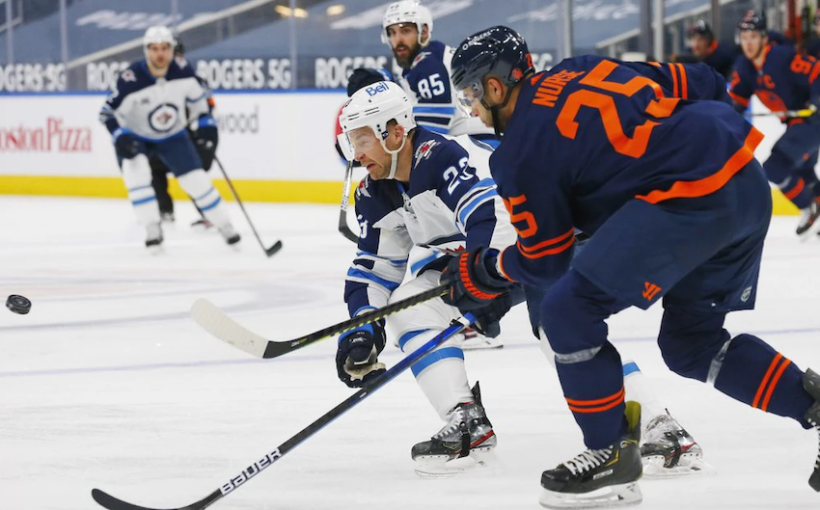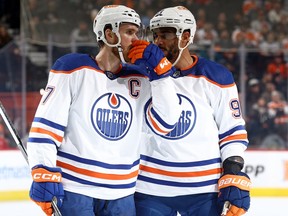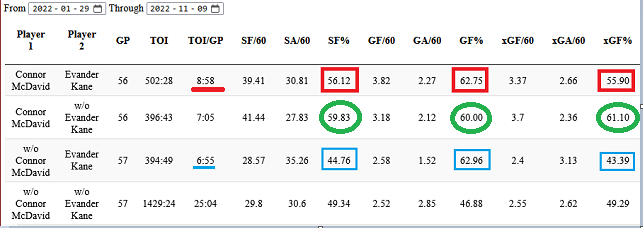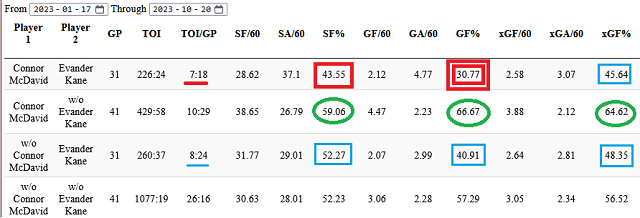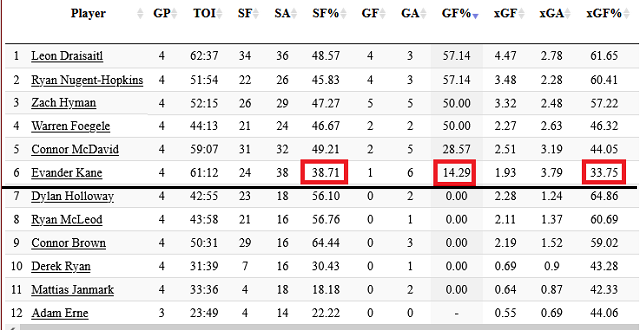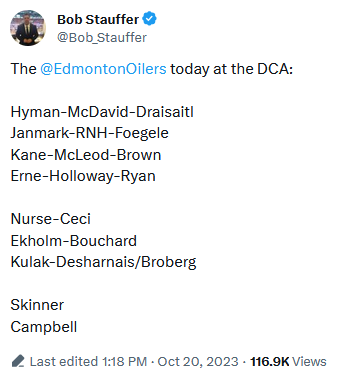Milan Lucic
- 2016 Oct 12 – 2017 Dec 31: 121 GP, 32-44-76, +3
- 2018 Jan 01 – 2019 Apr 06: 122 GP, 7-21-28, -27
The Oilers had missed the playoffs in the last two of those seasons, and the heavy-legged play of the 6’3, 240-lb. power forward was widely tabbed as a major part of the problem. Freshly turned 31, there was little to suggest that he would turn things around.
Holland immediately set about solving the problem, and did so in one sense with his very first trade in this city. Two days after the Oilers paid him another signing bonus, Lucic and the last four years of his ponderous pact were moved down the QE2 to Calgary for another aging power forward, James Neal. The exchange also included a conditional** third-round draft pick to Calgary, 4x $750,000 in cap retention, and $8 million in real cash that had been paid to the player over and above his cap hit in his front-loaded, bonus-heavy pact. (**The condition, a 20-goal season by Neal, was not met but the pick was nonetheless ceded to Calgary via a controversial league ruling.) Ouch.
James Neal
Enter aging power forward #2, James Neal. The 6’3, 212 pound winger was already 32 and had four years left on his own pact at $5.750 million per, though at least his deal had none of the high-bonus, no-move structure of the Lucic boat anchor. It did, however, harbour the other two horsemen of the apocalypse: term and cap hit.
Neal had a very promising start with the Oilers as a goal scorer, but it was a mirage.
- 2019 Oct 02 – 2019 Dec 31: 42 GP, 19-8-27, -23
- 2020 Jan 01 – 2021 May 15: 42 GP, 5-9-14, +1
After notching a hat trick on New Year’s Eve to reach 19 goals, the calendar turned and so did Neal’s hands — to stone. (Further) slowed by a broken foot, he didn’t score again that season, and tallied just 5 times in the one that followed. In that year and a half he missed as many games (43) as he played (42) while spending time on injured reserve, the taxi squad and the press box.
Once again Holland stepped up to solve the problem, choosing to buy out the last 2 years of Neal’s pact in the summer of 2021. That opened up both a roster spot and some cap space, but nonetheless involved taking on a 4 years of dead cap at $1.917 million per. Ouch, again.
Zack Kassian
In the meantime, Holland was encountering yet a third headache at the “vet power forward” spot, this one of his own doing. In January of 2020, he signed forward Zack Kassian, freshly turned 29, to a (wait for it) four-year extension at $3.2 milliion per. Kassian, who had “caught a wave” as the right winger on the Connor McDavid–Leon Draisaitl line for the entirety of calendar 2019, was enjoying a productive stretch. For balance, let’s take it back to the start of 2018-19.
- 2018 Oct 01-2020 Jan 28: 123 GP, 28-26-54, -1
- 2020 Jan 29 – 2022 Apr 29: 100 GP, 10-20-30, -7
In this case our dividing line is the day Kassian signed that extension, in mid-season of 2019-20. The 6’3, 211 lb winger’s production fell off almost immediately and never recovered, in part due to a series of injuries that befell the suddenly-aging power forward. Halfway through that disastrous pact, Holland got out from under its last two years by sending Kassian along with three future draft assets to Arizona. The Oilers would move down in the first round of that day’s 2022 NHL Draft, and today remain on the hook for a third-round pick in 2024 and a second-rounder in 2025. Ouch, yet a third time.
Evander Kane
At least the Oilers were finally free of long-term contracts to aging power forwards, right? Not so fast. Just two weeks later, Holland re-upped Evander Kane to an extension of (wait for it) four years, at an annual cap hit of $5.125 million. Kane had made an impressive debut with the Oilers the previous season as a mid-season free agent, scoring 22 goals in barely half a season. But he too was about to turn 31, a dangerous age for power forwards as Oil fans could certainly attest by then.
Kane had a decent start to the following season, before being felled by a series of injuries. The most serious was a lacerated wrist that sidelined him for 10 weeks, followed by broken ribs and in the playoffs, a broken hand. Some of it bad luck, for sure; the wrist injury could have happened to pretty much anybody, not just a 30-something power forward. Still, that grotesque bodily insult was a pretty clear division in Kane’s time with Edmonton to date:
- 2022 Jan 29 – 2022 Nov 08: 57 GP, 27-25-52, +29
- 2023 Jan 17 – 2023 Oct 19: 31 GP, 11-5-16, -13
Also:
- 2022 playoffs: 15 GP, 13-4-17, +2
- 2023 playoffs: 12 GP, 3-2-5, -3
Again, we have what appears to be two different players that is in fact the same man before and after injuries and/or age caught up with him.
I’m not here to suggest any of those dings is the “fault” of the player, be it Neal, Kassian, or Kane. But there is a long track record that extends far beyond Edmonton to the NHL as a whole that power forwards in their early 30s are something of an endangered species. And unfortunately, the Oilers always seem to have at least one of them locked up to a four-year deal with a significant cap hit.
Today that player is Evander Kane, who checks a lot of boxes in the “power forward” department. Posts lots of crooked numbers in the goals, shots, hits and penalty minutes columns, has his teammates’ backs and the capacity to be a major pain in the side if not a flat-out distraction to opposing teams. Lots to like in this player.
But since returning (ahead of schedule) from the first of those injuries, his trajectory has taken a hard turn in the wrong direction, and at both ends of the ice. By eye the player is noticeably slower and struggles to handle the puck cleanly. By stat, well, let’s dig in a bit.
The focus here will be on Kane’s results with and without his most common linemate, Connor McDavid, and more importantly on McDavid’s with and without Kane.
Right up until the injury, they were flying high whether together or apart:
- Source: Natural Stat Trick
From the day Kane joined the team until the time of that horrific wrist injury, he and McDavid were a regular partnership. Each played well over half of his 5v5 minutes with the other, just over 500 minutes in all. During that time the Oilers outscored their opposition by 32 goals to 19; as a rate stat (as shown here), that’s a little over 1½ goals to the good for every 60 minutes together. Their 63% goal share was a little higher than underlying shots or expected goals, as might reasonably be expected when an above-average shooter teams with a far-above-average playmaker. Initially, it was an excellent partnership to say the least.
Of course, McDavid was a productive player whether teamed with Kane or not, logging around a 60% share in all three categories when separated. Kane on the other hand ran hot when separated from McDavid, continuing to post a 63% goal share despite the underlying numbers lagging below 45% in both cases. Or should I say Edmonton goalies ran hot when Kane played sans McDavid, allowing just 10 goals on 232 shots (.957). By flow of play, the Oilers did much worse in terms of both shots for and against in that scenario.
Since the injury, the McDavid-Kane partnership has taken a hard turn for the worse.
In the 31 regular season games since Kane’s return that both were in the line-up, their ice time together has been cut back a little, but they’ve continued to average well over 7 minutes a night together, nearly 4 hours in total. Their results have been nothing short of disastrous: 8 goals for, 18 against at 5v5 for a horrible 31% goal share. Their shot and expected goal shares both hover in the 45% range, not quite so terrible but astonishingly poor for a regular duo that includes the reigning Most Valuable Player. McDavid should in theory raise the level of everybody he plays with, but in this case it just isn’t working. At. All.
Playing with others, McDavid continues to sail along. In 41 games over that span (Kane missed 10 of them), he’s been on the ice for 32 goals for, 16 against, a nifty 67% goal share at 5v5. His on-ice shares of shots and expected goals have been almost as lofty.
It’s been more of the same in the early going of 2023-24. Just 4 games so I’ll spare you the Line Tool charts, but will point out that in 41 minutes together the Oilers have just 43% of the shots, 40% of the expected goals, and 20% of the actual goals (1 for, 4 against). When separated, McDavid has been fine (65% / 55% / 50% in 18 minutes), while Kane has struggled (25% / 16% / 0% in 20 minutes).
Here are season-to-date numbers for the forward corps at 5v5, sorted by goal share:
The bottom 6 all land at 0% since they collectively haven’t produced a single tally to date. But Kane’s goal differential of 1 for, 6 against in barely an hour of action is by some distance the poorest among forwards to this early date.
This as he starts his 32-year-old season, with three years remaining on his hefty ticket. Did I mention Ken Holland has a headache at the “veteran power forward” position?
What to do?
In the short term it appears Kane is headed down the line-up for a while. He found himself skating in the bottom 6 at times during Thursday’s desultory loss in Philadelphia, and again in practice on Friday when coach Jay Woodcroft rolled out new line combos:
Looks like Zach Hyman has landed in the cherished spot alongside McDavid and Draisaitl that had been reserved for Kane in the prior two games that the power couple teamed up. Eyebrows raised at the appearance of another to-date-unproductive vet, Mattias Janmark, on the second line while the people’s choice, promising young Dylan Holloway, has temporarily landed at 4C. But to these eyes, the most significant change here is the rare appearance of Evander Kane on a depth line.
Given how much the club has invested in him, Oil fans can only help this will be a temporary blip as the player recovers his form. That said, he’s been trying to do just that for the past 9 months, and things haven’t been working well.
Give the player his due, he’s trying. In what can only be considered a poor performance by the team as a whole in Philly, Kane was personally credited with 5 of Edmonton’s paltry 23 shots; with 5 of their measly 16 hits; and with both of their 2 takeaways. One can point the finger at a lot of players who had a worse game than Evander Kane. Despite those crooked individual numbers, though, his on-ice numbers were poor, and he ended the night dash-1.
In the longer term, the trend has been as clear as it’s been disturbing. For now, where he fits in the line-up is Jay Woodcorft’s problem to solve, but in due course the Kane file may well land back on Ken Holland’s desk. Or his successor’s as a future legacy project.
In the meantime, all Oilers fans can do is watch, wait, and wish for a return to better form.
